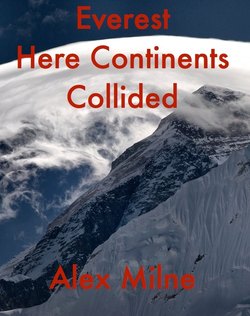Читать книгу Everest Here Continents Collided - Alex W Milne - Страница 10
На сайте Литреса книга снята с продажи.
Structural and Geological Elements of Nepal
ОглавлениеThe structure of the collision zone is presented in the Structural Elements of Nepal above. The map highlights the nature of the collision zone to the south of the Indus Tsangpo Suture Zone, i. e. the collision zone on the leading edge of the Indian plate. The key structural elements are from north to south, the South Tibetan Detachment System, the Main Central Thrust and the Main Boundary Thrust. The structural elements define three principle provinces, the Tethyan Himalaya, the Greater Himalaya and the Lesser Himalaya.
Gauri Shankar 7134 m. Everest mountain flight. Buddha Air. Layered gneisses of the Greater Himalayan Sequence.
Geology
Geological interpretation in the Khumbu is challenging. Much of the rock outcrop is obscured by glaciers or glacial outwash and at lower altitudes, vegetation. Some of the best outcrops are on, as yet, unclimbed faces. These huge expanses of rock give us some of the finest exposures of "thrust crust" in the world. To walk around the high Khumbu is an opportunity to look deeply into what the Earth’s crust is and what processes are taking place within. Finally, collision is ongoing and consequently the mountains continue to rise. GPS measurements made on the South Col suggest that Everest is rising at 4 mm per year. It is therefore no coincidence that these older, harder rocks, given the youthfulness of the collision, are the highest mountains in the world. A corollary to this and a feature of young active mountain building systems, is the “sharp” nature of the mountains and the very substantial erosion and rock debris being carried off by the glaciers.
The evolution of the India to Eurasian collision is believed to have commenced around 70 million years ago with the northwards drift of the Indian continent. During this time Tethyan marine sediments were subducting beneath the Eurasian plate. 20 million years ago India progressively collided with Eurasia. The evidence for this is found within the sediments of the Indus Tsangpo Suture Zone and from remnants of marine sediments along the Indian plate of Early Eocene age. Following collision, the Indian plate continued to push northwards with accompanying shortening and thickening across the Tethyan margin, north of the South Tibetan Detachment. Peak burial metamorphism occurred within the Oligocene around 32 million years ago. Temperatures remained high between 32 and 17 million years - Searle (2003). The crust was progressively exhumed southwards and metamorphism ended. Around about this time the northward normal faulting of the Qomolangma Detachment formed.
There follows a series of diagrams which show the age and structural relationship of the Everest region rocks. Followed by an in depth discussion about the metamorphic history of the area.
Solid geology map inspired by my trek in the Khumbu and by Mike Searle’s map published in 2003. This detailed geological map is available by contacting Professor Searle. See links at the end of the book.
Map showing location of the cross-sections. Section A A' extends beyond the northern limit of the map and is included for clarity.
Cross sections north-south and east-west.
